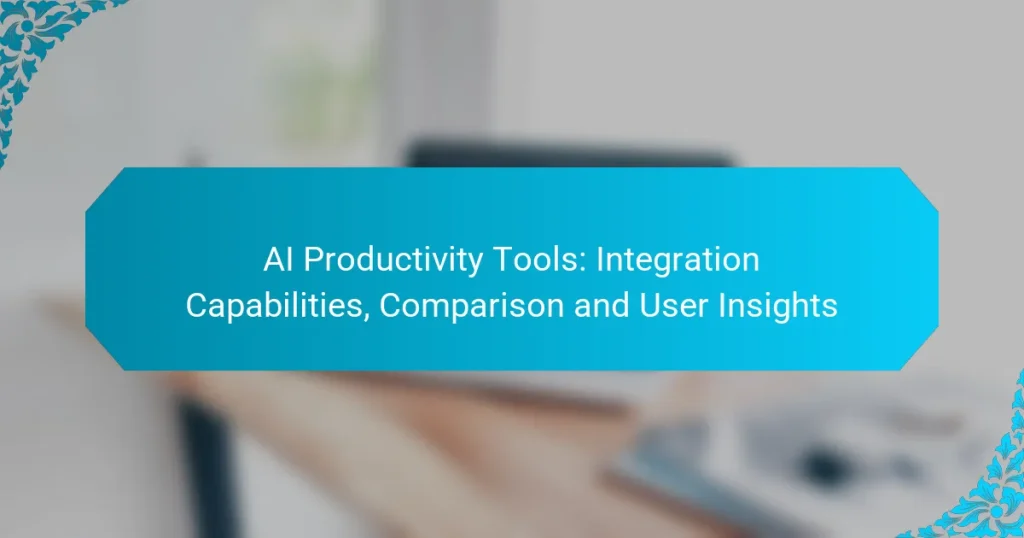AI productivity tools are designed to enhance efficiency by automating repetitive tasks and streamlining workflows through seamless integration with various applications. With options like Zapier, Integromat, and Microsoft Power Automate, users can customize their workflows to suit specific business needs, allowing for improved organization and communication. These tools not only reduce manual effort but also enable teams to focus on higher-value activities, ultimately driving productivity and effectiveness.
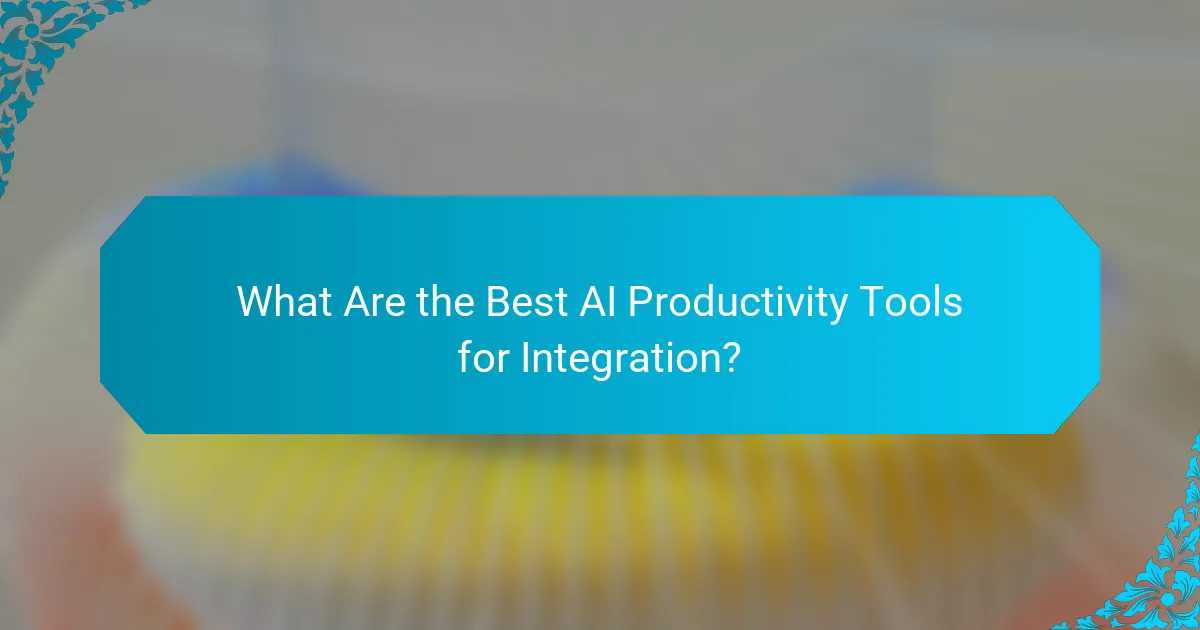
What Are the Best AI Productivity Tools for Integration?
The best AI productivity tools for integration streamline workflows by connecting various applications, enhancing efficiency. Key options include Zapier, Integromat, Microsoft Power Automate, Automate.io, and Tray.io, each offering unique features and capabilities to suit different business needs.
Zapier
Zapier is a leading integration tool that connects over 3,000 applications, allowing users to automate repetitive tasks without coding. It operates on a trigger-action model, where an event in one app triggers an action in another.
For example, you can set up a Zap to automatically save email attachments from Gmail to Google Drive. This tool is ideal for small to medium-sized businesses looking to enhance productivity quickly.
Integromat
Integromat, now rebranded as Make, provides a visual platform for creating complex integrations between apps. It allows users to design workflows with multiple steps and conditional logic, making it suitable for advanced automation needs.
For instance, you can create a scenario that pulls data from a Google Sheet, processes it, and sends customized emails via Mailchimp. Integromat is particularly beneficial for users who require detailed control over their automation processes.
Microsoft Power Automate
Microsoft Power Automate integrates seamlessly with Microsoft 365 applications, making it a strong choice for organizations already using Microsoft products. It offers templates for common workflows and supports both simple and complex automation.
Users can automate tasks like syncing files between SharePoint and OneDrive or sending notifications in Teams. This tool is particularly advantageous for enterprises looking to leverage their existing Microsoft ecosystem.
Automate.io
Automate.io is a user-friendly integration tool that connects cloud applications through a simple drag-and-drop interface. It supports multi-step workflows and offers a variety of pre-built templates to help users get started quickly.
For example, you can automate the process of adding new leads from Facebook Ads to your CRM. Automate.io is ideal for small businesses seeking straightforward automation without a steep learning curve.
Tray.io
Tray.io is a powerful integration platform designed for businesses that need to connect multiple applications at scale. It offers a flexible, visual interface that allows users to build complex workflows with ease.
With Tray.io, users can integrate data from various sources, such as APIs and databases, enabling advanced data manipulation and reporting. This tool is best suited for larger organizations with sophisticated integration requirements.
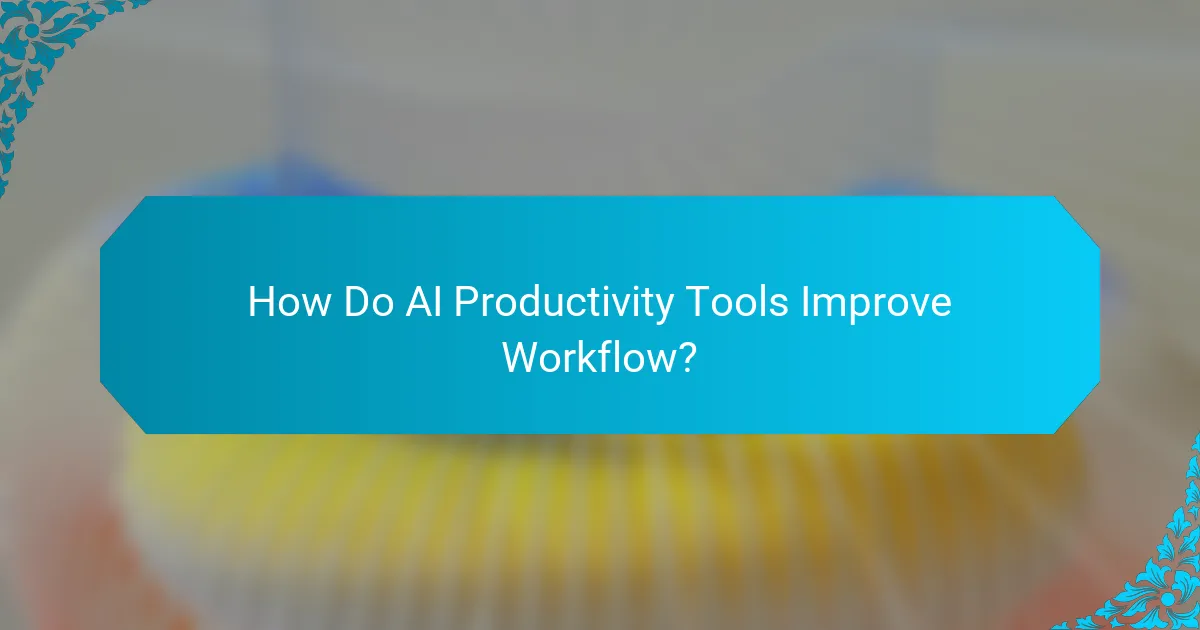
How Do AI Productivity Tools Improve Workflow?
AI productivity tools enhance workflow by automating repetitive tasks, improving organization, and facilitating communication among team members. These tools integrate seamlessly with existing systems, allowing users to focus on higher-value activities while minimizing manual effort.
Streamlined Task Management
AI productivity tools streamline task management by automating the assignment and tracking of tasks. They can prioritize work based on deadlines and importance, ensuring that team members are focused on the most critical activities.
For example, tools like Asana or Trello utilize AI to suggest task allocations based on team members’ workloads and past performance. This can lead to a more balanced distribution of work and improved project timelines.
Automated Data Entry
Automated data entry reduces the time spent on manual input by using AI to extract and input information from various sources. This capability minimizes human error and enhances data accuracy, which is crucial for decision-making.
Tools such as Zapier or Microsoft Power Automate can connect different applications, allowing data to flow seamlessly between them without manual intervention. This can save users significant time, often reducing data entry tasks from hours to just minutes.
Enhanced Collaboration
AI productivity tools enhance collaboration by providing real-time communication and feedback mechanisms. Features like shared dashboards and instant messaging allow teams to stay connected and informed, regardless of their physical location.
Platforms like Slack or Microsoft Teams incorporate AI to summarize discussions and highlight important updates, ensuring that all team members are on the same page. This fosters a more cohesive work environment and can lead to faster project completion.
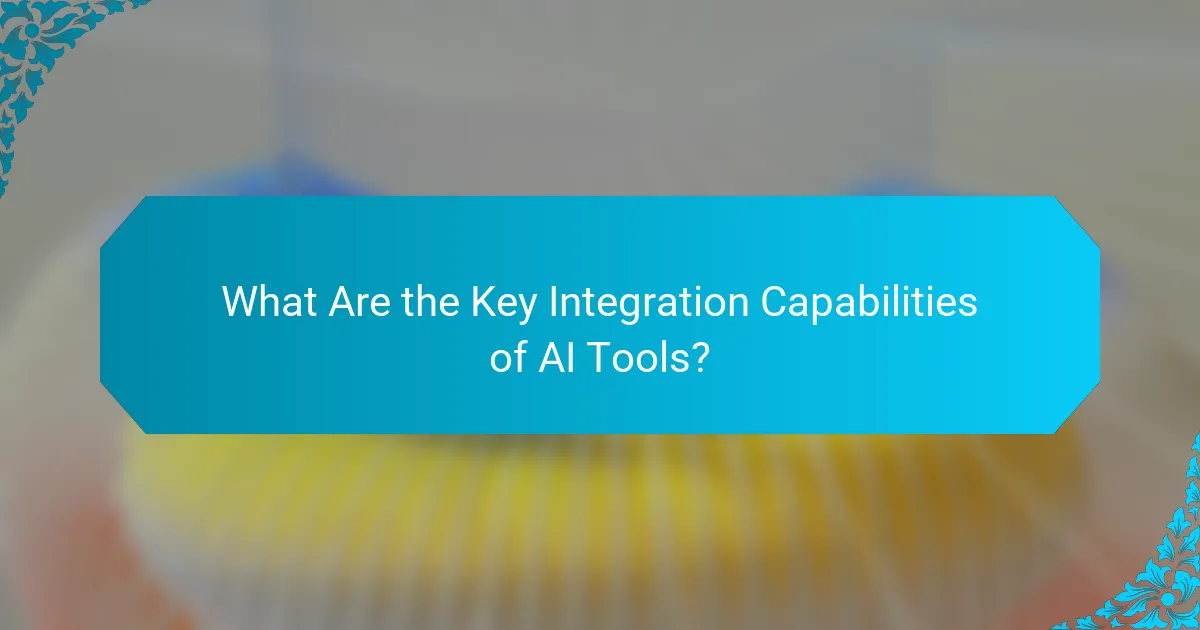
What Are the Key Integration Capabilities of AI Tools?
AI productivity tools often excel in integration capabilities, allowing them to connect seamlessly with other software and services. Key integration features include API connectivity, support for third-party applications, and the ability to automate custom workflows.
API Connectivity
API connectivity is crucial for AI tools, as it enables them to communicate with other software applications. A well-designed API allows for data exchange and functionality integration, making it easier to incorporate AI features into existing systems.
When evaluating API connectivity, consider factors such as response time, data formats supported, and authentication methods. Tools with RESTful APIs are generally preferred due to their simplicity and widespread adoption.
Third-Party App Support
Support for third-party applications enhances the versatility of AI tools by allowing users to integrate them with popular software like CRM systems, project management tools, and communication platforms. This capability can significantly streamline workflows and improve productivity.
When choosing an AI tool, check the list of supported third-party apps. Tools that offer extensive app marketplaces or integration hubs can provide more flexibility and options for customization.
Custom Workflow Automation
Custom workflow automation allows users to create tailored processes that leverage AI capabilities, reducing manual tasks and improving efficiency. This feature often includes drag-and-drop interfaces for easy setup and modification of workflows.
To maximize the benefits of custom automation, identify repetitive tasks that can be streamlined. Look for tools that offer pre-built templates or examples to help you get started quickly. Avoid overly complex automations that may require extensive maintenance or troubleshooting.

How to Choose the Right AI Productivity Tool?
Choosing the right AI productivity tool involves assessing your specific needs, understanding integration capabilities, and evaluating user experience and pricing models. A well-suited tool should enhance efficiency without complicating existing workflows.
Assess Integration Needs
Start by identifying the systems and applications your team currently uses. Look for AI tools that seamlessly integrate with these platforms, as this will minimize disruption and maximize productivity. Common integrations include project management software, communication tools, and data analytics platforms.
Consider the ease of integration as well. Tools that offer APIs or pre-built connectors can save time and reduce technical challenges. For instance, if your team relies on platforms like Slack or Trello, ensure the AI tool can connect effortlessly with these services.
Evaluate User Experience
User experience is crucial for adoption and productivity. A tool should be intuitive and easy to navigate, allowing users to focus on their tasks rather than learning complex functionalities. Look for platforms that offer user-friendly interfaces and customizable features.
Gather feedback from potential users through trials or demos. This can provide insights into how well the tool meets their needs and whether it enhances their workflow. Pay attention to aspects like responsiveness, support resources, and community engagement.
Consider Pricing Models
Pricing models for AI productivity tools can vary widely, from subscription-based plans to one-time purchases. Evaluate your budget and the expected return on investment. Many tools offer tiered pricing, allowing you to choose a plan that fits your team size and feature requirements.
Be cautious of hidden costs, such as fees for additional users or premium features. It’s often beneficial to start with a free trial or a basic plan to assess the tool’s effectiveness before committing to a more expensive option.
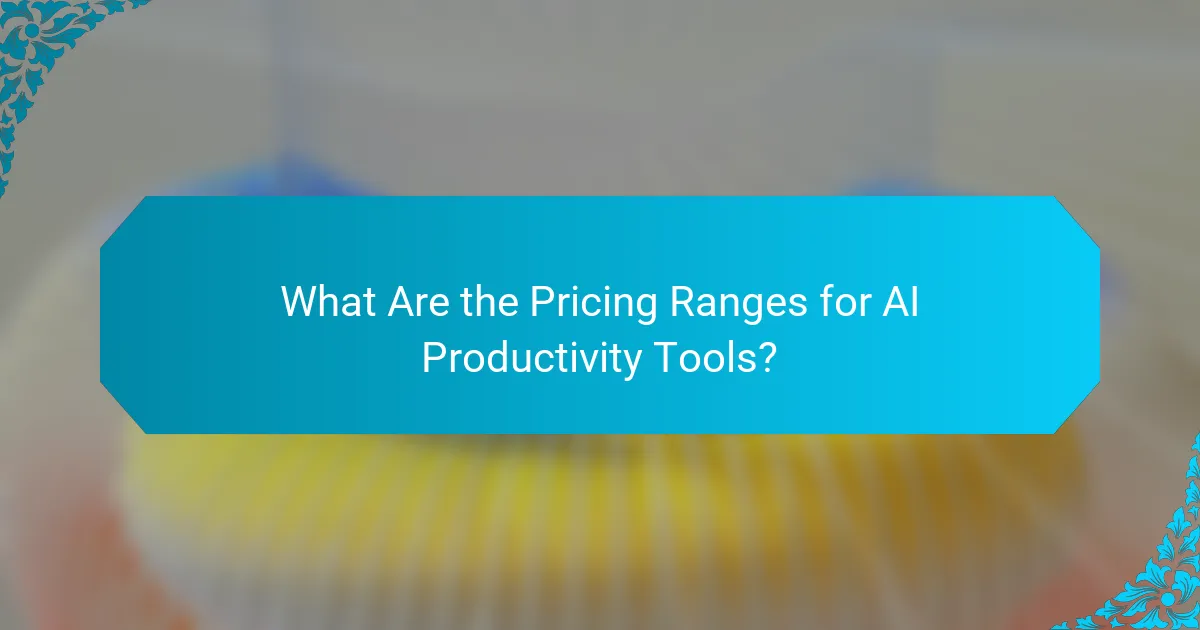
What Are the Pricing Ranges for AI Productivity Tools?
The pricing for AI productivity tools varies widely based on features, user limits, and integration capabilities. Generally, users can expect to find options ranging from free plans to subscription models that can cost anywhere from a few dollars to several hundred per month.
Free Plans
Many AI productivity tools offer free plans that provide basic features, allowing users to test the software before committing financially. These plans often come with limitations, such as reduced functionality, user caps, or restricted access to premium features.
For example, a free plan might allow a single user to access essential tools but limit the number of integrations or the amount of data processed. This can be a great way for individuals or small teams to explore the capabilities of the software without any financial commitment.
Subscription Models
Subscription models for AI productivity tools typically range from monthly to annual payments, with prices varying based on the level of service. Basic subscriptions may start around $10 to $30 per month, while more advanced plans can exceed $100 monthly, especially for teams or enterprises requiring extensive features.
When choosing a subscription, consider the specific features you need, such as advanced analytics, collaboration tools, or integration with other software. It’s often beneficial to compare different plans and take advantage of free trials to determine which option best fits your requirements.
